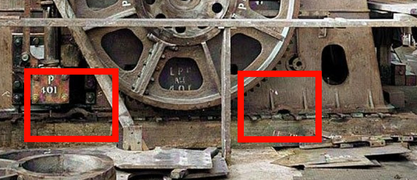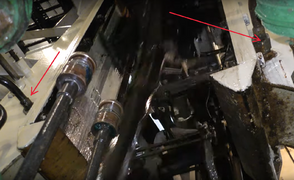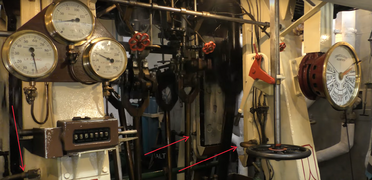Water Service.
Engines are fitted with a system of water
service by which cool sea water may be circulated through a bearing
or guide, or sprayed on any part liable to heating.
Collars of thrust bearings, main bearings and crosshead guides
are now usually cast hollow to allow for the circulation of water.
On some recent large engines the crossheads are fitted with a telescopic
water service to enable water to circulate through these.
In order to keep the large amount of water, which cornes through
the water service, out of the bilge and crank pits, some vessels
have the water service arranged so that the water which circulates
through the main bearings, guides and thrust bearings is led to the
suction of the circulating pump. As thus arranged, the water service
for these parts is a closed circuit.
There are usually a number of hose connections on the water
service so that a hose can be attached and cooling water led to any
desired place in engine room. These connections may also be used
in washing down the engine room.
The repair work that the water service will require consists of
grinding in its valves, tightening up on joints and unions and rebrazing
broken joints. .
The water service should be shut off about half an hour before
coming to an anchor so as to leave only clean oil on the surface of
the bearings when engines are stopped.
The following are the specifications for water service of recent
U. S. naval vessels.
"There will be in each engine room a 4-inch water-service pipe,
with a 4-inch branch to the main engine and a 2-inch branch to
the shaft alley, and smaller branches leading to different parts of
the engine and shaft, as follows:
One 1¼-inch branch with swivel joint for each crank-shaft bearing;
Two 1¼-inch pipes to each crank pin;
Two 1-inch pipes to each crosshead;
One 1-inch pipe to each go-ahead crosshead guide;
One 1-inch pipe to each pair of eccentrics;
One 1½-inch pipe to each thrust bearing;
One 1-inch pipe to each line-shaft bearing;
One t-inch pipe to each hollow brass or its equivalent in crankshaft
bearings;
Two 1-inch pipes to each air-pump engine and to each circulating
pump engine.
Each of the above branches will have a separate valve and will
terminate, as may be directed or approved, either in a pivoted nozzle,
a detachable spray nozzle, a short length of hose, or a permanent
connection to the part to be cooled.
The water-service pipe will be connected so as to take water
from the casing of the main circulating pump. There will be a stop
valve in the water-service pipe near the connection.
The water-service discharge pipes from crosshead guides, main
bearings and thrust bearing will connect to the suction side of the
main circulating pump, so that the water may pass overboard instead
of into the bilges.
There will be a system of water-service pipes for auxiliary machinery
in any part of the ship, as may be directed. These pipes
will be of approved size, thickness and arrangement, and will connect
with sea valves or pipes where directed."

 ...This latest vid brings the previous images to life.
...This latest vid brings the previous images to life. 




